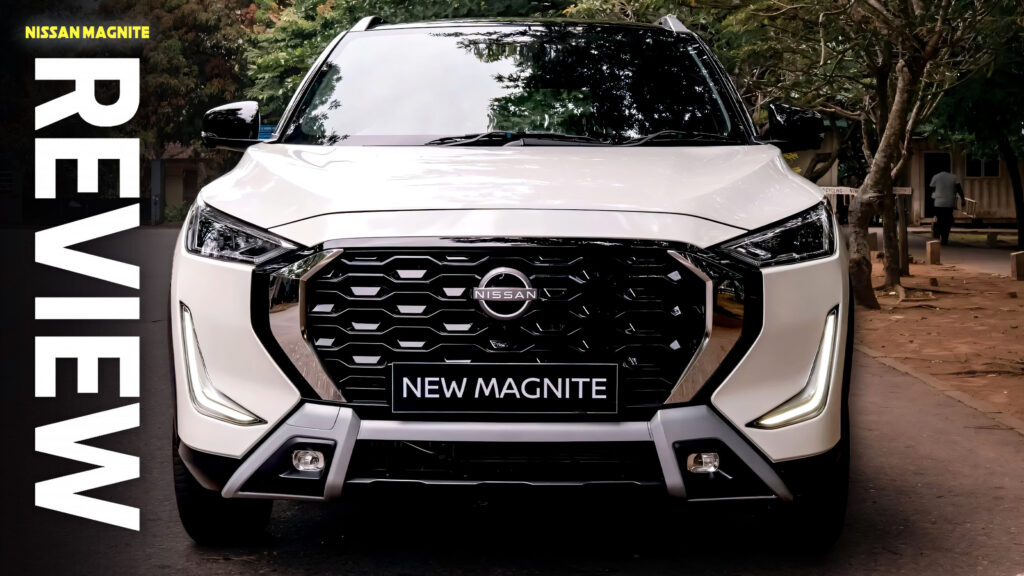
Nissan’s troubles are well documented, as is the company’s somewhat rocky “alliance” with Renault. However, there have been some successful ventures that, while not a silver bullet for the company’s woes, may provide some buoyancy to investors’ dreams of a turnaround.
Take this, the Nissan Magnite. It’s a car that will likely never see the light of day on North American or European roads. Instead, its target demographic is wholly different: developing nations, where a cost-competitive product can generate large volume.
var adpushup = window.adpushup = window.adpushup || {que:[]};
adpushup.que.push(function() {
if (adpushup.config.platform !== “DESKTOP”){
adpushup.triggerAd(“0f7e3106-c4d6-4db4-8135-c508879a76f8”);
} else {
adpushup.triggerAd(“82503191-e1d1-435a-874f-9c78a2a54a2f”);
}
});
What The Heck Is A Magnite?
At the Sri Lankan launch event, we were given the usual marketing spiel about how the Magnite fuses the words “Magnetic” and “Ignite” together. There was even mention of a technology it shared with the venerable GT-R… Yes, we smirked, but it was essentially some kind of engine bore coating developed for the supercar that has trickled down to Nissan’s lower-capacity models.
But, portmanteaus and tenuous supercar links aside, essentially, the Magnite is a subcompact crossover SUV that has been tailored for the Indian and Asian subcontinent markets.
Quick Facts
SWIPE
It uses the DNA from the Renault Kwid, a hatchback that took the fight to the entry-level Maruti Suzuki Alto in India. But whereas the Kwid’s CMF-A platform was distinctly small, the Magnite sits on the so-called B-SUV CMF-A+ platform that’s longer and larger.
The Magnite wasn’t supposed to be a Nissan at all. In fact, it was supposed to be a Datsun. No, not the one that changed its name in 1986. In 2013, the Renault-Nissan alliance, in one of their misguided escapades, decided to resurrect the Datsun name for the Indian and low-cost export market. But with little brand equity to relate to in those markets, as well as abysmal crash test scores and a poor dealer network, the newly revived Datsun brand died a quick death. It is missed by no one.
With Datsun phased out, the Magnite transitioned into a Nissan product, but retained its Indian manufacturing and focus on providing a budget-oriented package. However, quality was stepped up, as was the focus on achieving safety rating scores of more than 0 stars.
The Magnite Today
var adpushup = window.adpushup = window.adpushup || {que:[]};
adpushup.que.push(function() {
if (adpushup.config.platform !== “DESKTOP”){
adpushup.triggerAd(“bb7964e9-07de-4b06-a83e-ead35079d53c”);
} else {
adpushup.triggerAd(“9b1169d9-7a89-4971-a77f-1397f7588751”);
}
});
Since its launch in 2020, the Nissan Magnite has undergone a couple of revisions, including a facelift in late 2024, which brought in a revised exterior and improved interior. It’s also exported to some 65 countries, with both right- and left-hand drive models available.
In its home market of India, and in the sub-four-meter-long SUV category, it’s going up against the Suzuki Fronx (and its Toyota rebadge, the Taisor), the Hyundai Exter, and the Tata Punch, not to mention its Renault sibling, the Kiger.
Read: Nissan Magnite Facelift Ready To Woo 47 New Markets As Apparently Everyone Loves Tiny SUVs
The facelift of the Magnite brings with it a large grille, which definitely channels some of the brand’s more premium offerings. But, get up close, and the plasticky-ness of that nose is just a bit off-putting. The front end is redeemed by Bi-LED headlamps and separate fog lamps — both of which are impressive for this category.
var adpushup = window.adpushup = window.adpushup || {que:[]};
adpushup.que.push(function() {
if (adpushup.config.platform !== “DESKTOP”){
adpushup.triggerAd(“b25ecba7-3bbb-4ea7-a3a8-dbea91695c07”);
} else {
adpushup.triggerAd(“e46c436a-adeb-4b5e-a2c7-56bc36561c10”);
}
});
There’s an integrated rear spoiler which helps add a bit of depth to the otherwise frumpy silhouette, and 16-inch alloy wheels. But perhaps most notable are the roof-rails, which are actually load-rated for up to 50 kg (110 lbs), rather than being purely decorative.
Interior Impressions

The interior comes in several color variations, with the top-spec models opting for the bright orange leatherette dash tops and fussily designed seat covers. While perhaps not to everyone’s taste, the stitching is consistent, the surfaces quite nice to the touch, and the seats have been purportedly treated with a chemical that helps reflect heat more effectively – a lifesaver for the tropical climates in which the Magnite is competing in.
In front of the driver lies a surprisingly high-quality screen, which, among other functions, can display the tire pressures. And, despite being completely digital, you get a bar-by-bar temperature gauge, as opposed to some of the singular cold and hot warning lights found in some budget hatchbacks and Kei cars.
The only real letdown from the interior is the central display. The touch functionality feels resistant to input, much like a touchscreen phone from the early 2010s. Meanwhile, the resolution just isn’t the best. In practice, it feels worse than the driver display ahead of you, and despite the cars we tested having 360-degree surround view, we found the picture quality to be more on the smudgy side of crisp.
Photos: Mohamed Shan for Carscoops
Rear seat space is surprisingly impressive, with the ability to slide your feet underneath the front occupants’ chairs, and even a flip-out armrest with some cupholders molded into it. In addition to the good leg room, headroom is decent too, while passengers will also find three three-point seatbelts, rear AC vents, and a USB charging outlet.
With the seats folded, you’ll get up to 960 liters of room, or 333 liters with them upright. The rear seat backs are 60/40 folding, but a small irritant is that there’s no tether to bring them back up from the trunk, meaning you’ll have to open the rear doors to reset them. The load area itself is quite spacious, with a trunk light as well. Key here, though, is that there’s a full-size (steel, not alloy) spare wheel, as opposed to a space saver or inflator kit found on most modern cars.
Out On The Road

When it comes to on-road manners, the Magnite is surprisingly composed. The suspension is tuned to handle potholes and speedbreakers, and while that translates into significant body roll, the chassis doesn’t let go. The same can’t be said of the Ceat Securadrive tires that came equipped with our vehicle, which break traction far before the chassis can.
Road noise is kept at acceptable, though not great, levels. NVH from the three-cylinder lump does rear its head at higher rpm – keep it sensible, and your eardrums will thank you. There’s a bit of wind noise, while the doors themselves lack that confident thunk sound, due to cost-cutting with thin metal, meaning you really need to slam the doors to get them closed in one go.
See Also: New Maruti Suzuki Brezza Revealed In India With Mild-Hybrid Tech
Despite its relatively small external dimensions, you do feel like you’re sitting fairly high up in the cabin, with good visibility out the front and sides. The dimensions are easy to gauge, making the camera system and rear parking sensors somewhat superfluous for all but the most novice of drivers.
You’re also kept relatively safe, with the latest Magnite passing the Global NCAP rating with five stars. That’s particularly notable when you consider the first iteration achieved just two stars back in 2020. There are six airbags, as well as traction control, and electronic stability control.
In terms of power, there are two options on offer. Both are three-cylinder 1.0-liter petrol engines, one with natural aspiration and the other with forced induction. And the option you choose will have a considerable impact on whether your experience is enjoyable or not. Manual transmissions are available across both turbo and non-turbo variants; the latter have the option of an automated manual transmission, with turbo cars getting an optional CVT.
We test-drove the non-turbo AMT version to start with, and it was, in a word, gutless. That’s perhaps unsurprising for something that has just 71 hp (72 PS / 53 kW). But, it’s not just the fact that the engine feels anemic; it’s that the automated manual just cannot anticipate the car’s powerband in any perceptible way. Of course, you have to adjust your driving style with an AMT – rather than just keeping the accelerator constant as in a torque-converter automatic, you’re encouraged to lift off the fast pedal when you want the car to change gear.
But the AMT in the Magnite (and to be honest, many AMTs in general) just doesn’t do this process smoothly. And woe betide you if you want to overtake something. Mashing the gas to trigger a kickdown can result in a delay of some 3-5 seconds. And when you find yourself in that lower cog, you’re reminded that you simply don’t have any power to call upon anyway.
Turbo Transformation

The variant with forced induction brings a night-and-day difference to the table. In addition to shedding the AMT in favor of a CVT gearbox, the snail adds a much-needed boost (pun intended) to the overall driving experience. The addition of 27 hp for a total of 99 hp (100 PS / 74 kW) may not sound like a lot. And, it isn’t. But, when you consider the numbers game — that it’s 39 percent more — it really does start to make sense.
With the turbocharged three-cylinder thrumming along, the Magnite is transformed into something vaguely enjoyable to drive. It’s not lightning fast, with the CVT sapping a bit of potential. But it manages to keep up with traffic, initiate safe overtakes, and generally feels more suited to highway running.
Conclusion
Objectively, you have to look at the Nissan Magnite for what it is: a dream of mobility for many, with features that you wouldn’t have found in a car in this price range 10 years ago, offered within the Asian subcontinent. On that basis, it’s a commendable entry by Nissan, which has seen meaningful safety improvements as the product has matured.
Is it a car that enthusiasts would enjoy? No. But for its target demographic, it does many things well, in a reasonably attractive package, with a badge that will win over those who want something different from a Tata, Maruti, or Mahindra.
In a time of increasing uncertainty, it’s competitive cars like the Magnite that may just make the Nissan brand that bit more appealing to those in emerging markets, even if it’ll never see the light of day in Western markets.
Photos: Mohamed Shan for Carscoops
#Drive #Nissan #Magnite #SUV #Asia #Storm #Review

